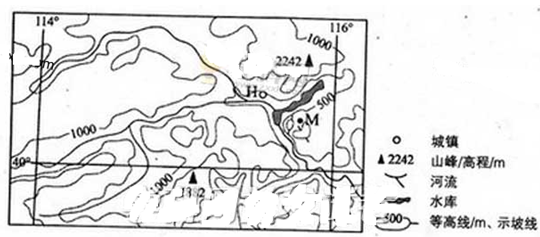(22分)阅读图文资料,完成下列要求。
在湿润和半湿润地区的湖畔、河边和海滨,偶见规模较小的沙丘群,其形成的主要条件为所在地区沙源丰畜、多风、植被稀疏。下图所示区城中,M处发育了规模较小的沙丘群;H县城附近是著名的风口,冬春季节风力尤为强劲;河流发源于黄土高原地区。

(1)分析M处附近沙源较丰富的原因。(6分)
(2)分析H县城附近冬春季节风力强劲的原因(8分)
(3)某课外活动小组的同学对M处的沙丘群规模是否会扩大产生了争论,形成了两种不同的观点。选择你支持的一种观点,为其提供论据。(8分)
观点A:M处沙丘群规模会扩大。
观点B:M处沙丘群规模不会扩大。
(1)(M处附近的)河流从黄土高原携带大量泥沙,在河边、河床沉积;(3分)(河水水位季节变化大,)枯水季节河床裸露;(2分)风沙在此沉积。(1分)
(2)冬春季节盛行西北季风(偏北风);(2分)河谷延伸方向与盛行风向基本一致(3分)H县城附近为河谷交汇之地,(形成风口,导致狭管效应)。(3分)
(3)观点A:(M处沙丘群规模会扩大)
论据:该区域西临黄土高原,北临内蒙古高原,大风可将沙尘吹到此处;(2分)河流持续搬运泥沙;(2分)人类活动用水量增加,导致河床裸露期增长;(2分)风出风口后,在M地速度降低,风沙在此沉积。(2分)
观点B:(M处沙丘规模不会扩大)
论据:位于半湿润区,降水较丰富,风沙发生季节短(主要发生在冬春季节);(2分)河流源地及流经地区植树造林保持水土(使河流搬运的泥沙量减少);(2分)沙源集中分布在河床与河边,面积较小,不足以形成面积较大的沙丘群;(2分)位于山区,附近有水库,沙丘群难以向周围扩展。(2分)
(每名考生选择一种观点作答,所提供的论据应支持所选择的观点,否则不得分。若两种观点都提供了论据,以所答的第一种观点评分)
(1)从文字材料中可以获取的信息是河流发源于黄土高原,黄土高原水土流失严重,河流携带的泥沙量大,在M处沉积;从图中来看,该地为温带季风气候,降水的季节变化大,多大风天气,枯水季节河床裸露,风力携带沙尘在此沉积。
该题主要考察我国黄土高原地区的自然特征。
(2)从文字材料中可以获知H县城附近是著名的风口,从图中来看该县城位于河谷中,且河谷走向与冬春季节的风向一致,形成狭管效应,故风力强劲。
该题主要考察等高线、地形对气候的影响。
(3)该题为开放性试题,无论选择哪种观点,只要言之有理,论据能够支撑自己的观点即可。考虑的要点主要是该地的主要自然特征以及图文资料所提供的信息。
该题主要考察我国特定区域的自然地理特征。
